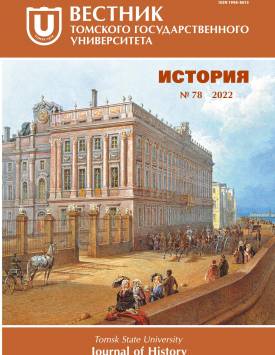West Siberian department of the All-Russian Association of Engineers in the 1920s: development and continuity
The article examines the activities of the Society of Siberian Engineers (since 1922 - the West Siberian department of the All-Russian Association of Engineers) in the 1920s. The tendencies of its pre-revolutionary development, as well as the processes of its revival after the Civil War are briefly outlined. For the first time, it is concluded that there is continuity between pre- and post-revolutionary variations of society, and its specific features are analyzed. The source base of the research was the materials of the societys periodical press, as well as unpublished office materials. The methodological tools include historical-descriptive, historical-comparative and historical-chronological methods, /as well as structural-diachronic analysis. The Society of Siberian Engineers was established in 1909 and successfully developed until the First World War, leading the researching of technical problems. With the beginning of the conflict, it began to provide assistance to the front, and since 1916 it began to cooperate with Zemgor. Under its influence, society abandoned apoliticality, and welcomed the February Revolution. In turn, the October Revolution was not accepted by society - it opposed the Soviet authorities. The new information about society was dated 1922, when the society, which had suffered serious personnel and financial losses, turned to Glavnauka to legalize its activities. The society successfully received approval from Glavnauka and adopted the new statute. No later than March 5, 1922 the society was renamed as the West Siberian department of the All-Russian (since December 1922 - All-Union) Association of Engineers. The department immediately began to recover lost positions. This was about both in the restoration of lost structural elements (journal, library, reading room), and in the revival of pre-revolutionary elements of his everyday life ("technical teas"). In the first half of the 1920s, the department demonstrated advanced growth. Since 1924 a collaboration of the department with Sibplan was established, and its gave an impetus to development of the organization (and also indicated commitment to the pre-revolutionary development strategy - Sibplan sponsored the department as Zemgor did at the time). However, in the second half of the decade, due to the gradual decline of the city, the department also began to demonstrate crisis phenomena. The attempt to unite with local engineering sections failed (which demonstrated the desire of the department to obtain trade union functions, as it had in pre-revolutionary time), and the department survived only through cooperation with Sibplan. With the initiation of the Shakhty Trial, the organization ceased its activities following the All-Union Association of Engineers. Thus, the Society of Siberian Engineers in the 1920s was able to successfully integrate into the new scientific and educational system and carried out activities largely based on its own pre-revolutionary experience. The author declares no conflicts of interests.
Keywords
Society of Siberian Engineers, Tomsk, technical intelligentsia, GlavnaukaAuthors
| Name | Organization | |
| Vyachisty Dmitry D. | Tomsk State University | dimdimvyachisty@yandex.ru |
References

West Siberian department of the All-Russian Association of Engineers in the 1920s: development and continuity | Tomsk State University Journal of History. 2022. № 78. DOI: 10.17223/19988613/78/2
